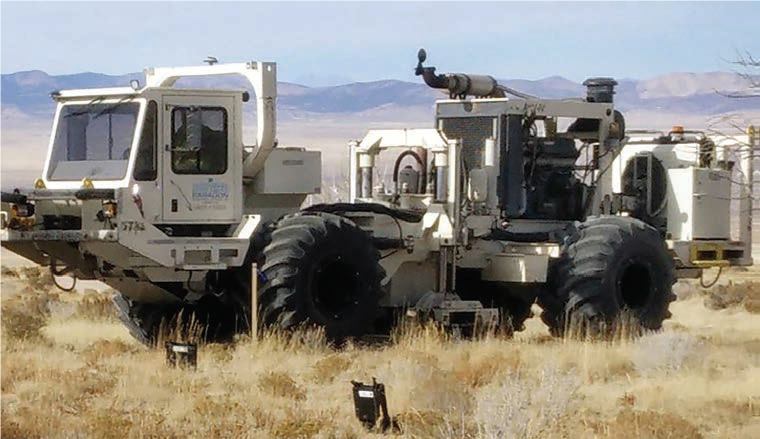By John Rogers
Utah is getting into the geothermal energy business in a big way.
A research site in Beaver County, operated by the University of Utah, has been selected by the U.S. Department of Energy (DOE) to receive up to $140 million in continued funding over the next five years for cutting-edge geothermal development. After three years of planning and site characterization, the proposed site outside of Milford has been selected as the location of the Frontier Observatory for Research in Geothermal Energy (FORGE) field laboratory. The Utah site was chosen over sites in California, Idaho, Nevada and Oregon to receive the funding for continued research and development of enhanced geothermal systems (EGS), or manmade geothermal reservoirs.
{mprestriction ids="1,3"}John McLennan, co-principal investigator of Utah’s FORGE team, said the funding was the result of a cooperative effort. He credited state support from Gov. Gary Herbert’s office, the Utah School and Trust Lands Administration and the state’s congressional delegation. “We thank the U.S. Department of Energy for this exceptional opportunity,” McLennan said.
The Energy Department had been considering the five potential sites for the FORGE project. Funding was approved in 2016 with the support of the National Energy Technology Laboratory to evaluate potential underground research sites, including the Utah location.
The University of Utah started working in 2013 to develop commercially viable plans for geothermal energy. Researchers in Beaver County identified potential well sites where “hot rocks” could make a FORGE-type project possible.
“Enhanced geothermal systems are the future of geothermal energy, and critical investments in EGS will help advance American leadership in clean energy innovation,” U.S. Secretary of Energy Rick Perry said in a press statement announcing the selection of the Utah site. “Funding efforts toward the next frontier in geothermal energy technologies will help diversify the United States’ domestic energy portfolio, enhance our energy access and increase our energy security.”
The project marks another energy-related development in the remote area around Milford, where large-scale solar and wind energy projects are already in operation. The area was the site of the first liquid-dominated geothermal plant in the U.S. when a project at Roosevelt Hot Springs was started in 1984.
“Conventional geothermal resources occur naturally in the U.S. but are geographically limited due to the necessary co-location of heat, permeability and fluid deep underground,” Perry continued. “Currently, American geothermal electricity production is located solely in the western states, where conventional geothermal resources put about 3.8 gigawatts of electricity on the grid.”
Manmade geothermal reservoirs can be engineered wherever hot rocks are found, according the DOE. “Since such formations are almost ubiquitous — they just vary in depth — those reservoirs have the potential to be utilized practically everywhere. EGS could significantly expand geothermal energy production, with an estimated 100 GW of currently inaccessible resources, removing the geographic barriers of conventional geothermal resources,” the department announcement said.
The Energy Department release continued, “Critical to broad EGS deployment, FORGE will be a laboratory where scientists and researchers can learn how to engineer these manmade systems. The geothermal community will gain a fundamental understanding of the key mechanisms controlling EGS success; develop, test and improve new techniques in an ideal EGS environment; and rapidly disseminate technical data and communicate to the public.”
The Beaver County Commission, Beaver city mayor and others posted a Facebook live stream expressing their excitement about being awarded the site for FORGE.
“Beaver County is very proud and very happy to receive this news today,” said Beaver County Commissioner Michael F. Dalton in the post. “It’s going to be a major economic impact to Beaver County for both employment and investment in technology.”
U.S. Rep. Chris Stewart, R-Utah, who helped to secure the funding from the DOE and represents Utah's 2nd Congressional District, where the Milford site is located, also issued a prepared statement. “I am thrilled for the university and Beaver County. This initiative highlights our world-renowned scientists and the groundbreaking research and development at the University of Utah. We’ve been producing geothermal energy for a hundred years but until now, production has been limited to sites with near perfect conditions. The University’s research revolutionizes production meaning that clean, reliable energy could be produced in thousands of locations. This will truly transform the energy industry,” Stewart said.
The plan for the Milford development involves drilling two 8,000-foot wells into the ground beneath the site. Water is sent underground into the heat of the earth and then drawn back up to the surface, where its steam can be used to move a turbine and generate electricity. Existing geothermal technology can be utilized in only a select few areas because it requires hot groundwater that can be extracted at the surface. The FORGE plant could create its own hot groundwater, making the technology usable nearly anywhere, according to a release from the University of Utah.
According to the university press release, the Milford facility would use only non-potable groundwater that could not otherwise be used for agriculture or human consumption.
{/mprestriction}








